In a previous blog about loudspeaker sensitivity, we looked at two readily available woofers to see how different specifications and construction techniques resulted in different amounts of low frequency output capability. For this discussion, we will take a single woofer design and see how using 1, 2 or 4 woofers affects total output capability. Doubling the number of woofers results in up to 6 dB greater output capability. Yes, 1+1 can equal 6!
Let’s model a high quality 15” woofer that is readily available “off the shelf”, and using the BassBox Pro simulation software we’ll see how increasing the number of woofers affects sensitivity and total output capability. We will use the Eminence Definimax 4015LF woofer in a 4 cubic foot ported enclosure (per woofer) that is tuned to 35 Hz. This woofer is designed for extended bass performance, so there is very little reduction of low frequency output due to cone excursion limits at reasonable power levels. In the real world, power compression* and other non-linear effects makes the actual peak output somewhat less than the theory, but we will see that increasing the number of woofers can be a really good way to achieve increased low frequency output.
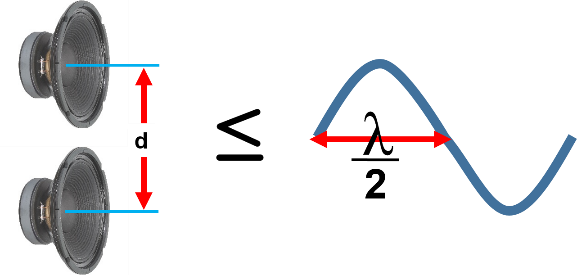
An effect called “mutual coupling**” increases the sensitivity of a loudspeaker system by 3 dB per doubling of drivers as long as the array size is small compared to the wavelength being reproduced. Getting the woofers as close together as possible will raise the upper limit of the effective frequency range.
As with most things related to acoustics, there are tradeoffs and you don’t really get something for nothing. The coverage angle of the array gets narrower at higher frequencies as the array size gets larger, so there are practical limits on the number of woofers that can be used. For a cinema LF system, up to 4 woofers provides extra LF output while maintaining a reasonable coverage angle up to 300 Hz. For cinema subwoofers, up to 8 woofers yields excellent results since subwoofer content is mostly below 100 Hz (very long wavelengths). Even more subs can be used, but the coupling effect may be diminished as the array size gets very large. You still get the benefit of reduced thermal power compression, lower distortion and greater reliability when using more than 8 subwoofer drivers.
Let’s look at the sensitivity of systems using 1, 2 and 4 woofers. We will see an increase of 3 dB in sensitivity every time we double the number of drivers. You can use the equation of 10*Log(N), where N is the number of woofers, to calculate the theoretical increase in sensitivity compared to a single woofer. Since we are only looking at the effect on sensitivity, we will hold input power at 600 watts for all three systems. The power in dBw is 10*LOG(600) or 27.8 dBw. While the Definimax woofer can take more power before destruction, 600 watts is a reasonable limit to use when factors like output linearity, low distortion and long life are taken in to account. With a single woofer, the green graph shows the theoretical SPL at 100 Hz is 124.9 dB. This implies a sensitivity of 124.9 – 27.8 = 97.1 dB. In reality, the peak output would be reduced by power compression, since 600 watts is a lot of heat to dissipate from a single woofer.
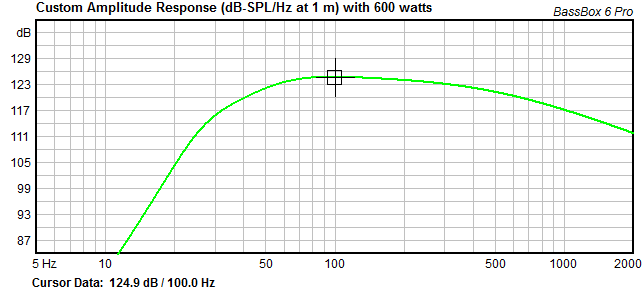
With a pair of woofers, the blue graph shows the theortical SPL has increased by 3 dB to 127.9 dB due to the 3 dB increase in sensitivity from mututal coupling. This implies a sensitivity of 127.9 – 27.8 = 100.1 dB. Power remains fixed at 600 watts but the power per woofer is now 300 watts. This reduces the amount of power compression and makes the real world output more linear than a single woofer for the same amount of total input power.
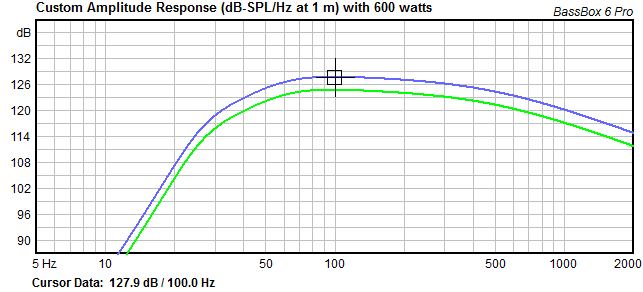
With four woofers, the red graph shows the theortical SPL has increased by another 3 dB to 130.9 dB, once again, due to the 3 dB increase in sensitivity from mututal coupling. This implies a sensitivity of 130.9 – 27.8 = 103.1 dB. Power remains fixed at 600 watts but the power per woofer is now only 150 watts. The woofers operate with much lower distortion at these power levels. As before, this further reduces the amount of power compression and makes the real world output much more linear than a single woofer for the same amount of total input power.
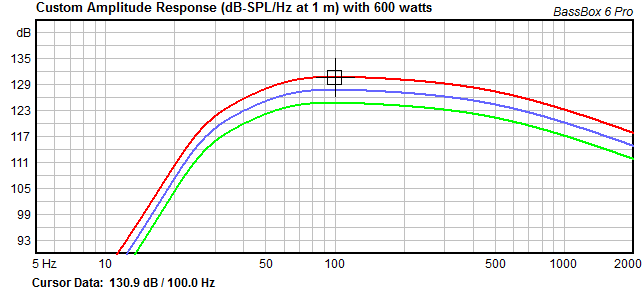
But what about the other 3 dB?
The increase in total SPL for doubling the number of drivers is the result in the increase of sensitivity by 3 dB due to mutual coupling plus the doubling of the power capacity, which adds another 3 dB. Let’s plot the thermal and mechanical power limits of the three systems. We can see that the increased power handling adds the additional 3 dB for each doubling of drivers. Remember that twice the power yields a theoretical 3 dB increase in SPL.
In the graph below, the flat part of the plot above 60 Hz represents the thermal power limit at 600 watts per driver and the curved portion of the plot below 60 Hz is the mechanical displacement limit due to how far the cone can travel before it becomes non-linear. For this design, the mechanical limit drops to a minimum at about 50 Hz. We will use 50 Hz as the frequency to compare total output of 1, 2 and 4 woofers.
We can see by the red graph that 4 woofers powered by 2400 watts has a theoretical output of 131.8 dB at 50 Hz. The blue graph for 2 woofers powered by 1200 watts drops by 6 dB to 125.8 dB and the green graph for a single woofer drops a further 6 dB to 119.8 dB.
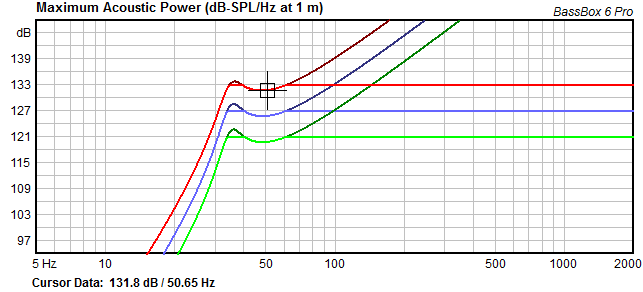
This illustrates how doubling the number of woofers increases output by 6 dB. Again, half of the increase is because of the sensitivity going up by 3 dB due to mutual coupling and 3 dB is due to doubling the total power capacity. The important corollary to this is that it is virtually impossible to increase output by just adding more power to an inadequate number of woofers. As power goes up, thermal heating of the voice coil causes the resistance to increase and results in thermal power compression becoming an even greater factor and at low frequencies, the mechanical displacement limit is the actual limit to spl increases, not input power.
…”it is virtually impossible to increase output by just adding more power to an inadequate number of woofers.”
To Prove My Point
Let’s attempt to increase the output of a single woofer by 6 dB by increasing the power by a factor of four. Instead of 600 watts, we will use 2400 watts. If thermal power compression and other non-linearities were not taken into account, the math says that this should equal the output of a dual woofer system with only 1200 watts of power. The dual woofer system is shown in blue and the single woofer is in green.
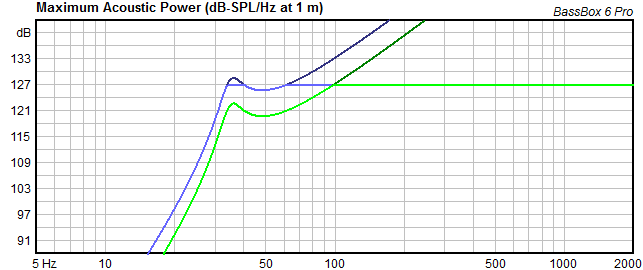
We can see that the theoretical output above 100 Hz would be the same but the single woofer system reaches mechanical displacement limits below 100 Hz long before the full 2400 watts can be applied. The single woofer is still about 6 dB down at 50 Hz from a dual woofer system even with virtually unlimited power input. Also, thermal power compression would be much greater and distortion is going to be higher as the cone attempts to travel beyond its physical limits.
Clearly, using an adequate number of woofers is the key to a high performance cinema LF system or subwoofer. The “free” sensitivity increase due to mutual coupling, the reduction in thermal power compression due to “spreading the load” over multiple voice coils, and the additional displacement added by having more cones cannot be countered by simply adding more power to fewer drivers.
* During normal operation, the voice coil in a loudspeaker heats up , which increases the DC resistance of the coil. This reduces the power transfer from the amplifier. Managing heat dissipating in a loudspeaker can reduce the amount of power compression.
** Mutual coupling will occur when the frequency is such that the center-to-center distance between the woofers’ acoustical centers is less than about one-half wavelength.

Great information!
332249 743245The subsequent time I read a weblog, I hope that it doesnt disappoint me as a lot as this one. I mean, I know it was my option to read, but I truly thought youd have something attention-grabbing to say. All I hear is really a bunch of whining about something which you possibly can repair ought to you werent too busy on the lookout for attention. 649336
You made some decent points there. I checked on the web to learn more about the issue and found most individuals will go along with your views on this website.
Нужен эвакуатор? вызвать эвакуатор быстрый выезд по Санкт-Петербургу и области. Аккуратно погрузим легковое авто, кроссовер, мотоцикл. Перевозка после ДТП и поломок, помощь с запуском/колесом. Прозрачная цена, без навязываний.
Нужны заклепки? заклепка вытяжная нержавеющая 4 8 для прочного соединения листового металла и профиля. Стойкость к коррозии, аккуратная головка, надежная фиксация даже при вибрациях. Подбор размеров и типа борта, быстрая отгрузка и доставка.
Great post.
fin88
Полная версия по ссылке: Продать орден Ленина — скупка в Москве
Нужен эвакуатор? срочный вызов эвакуатора быстрый выезд по Санкт-Петербургу и области. Аккуратно погрузим легковое авто, кроссовер, мотоцикл. Перевозка после ДТП и поломок, помощь с запуском/колесом. Прозрачная цена, без навязываний.
Hello, after reading this awesome piece of writing i am too glad to share my know-how
here with mates.